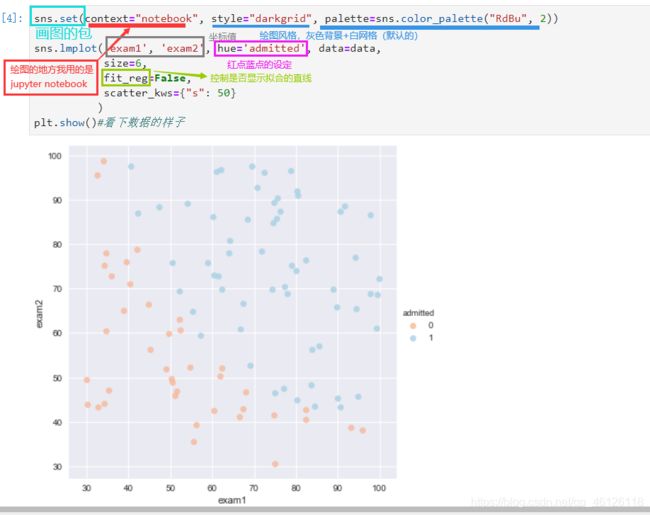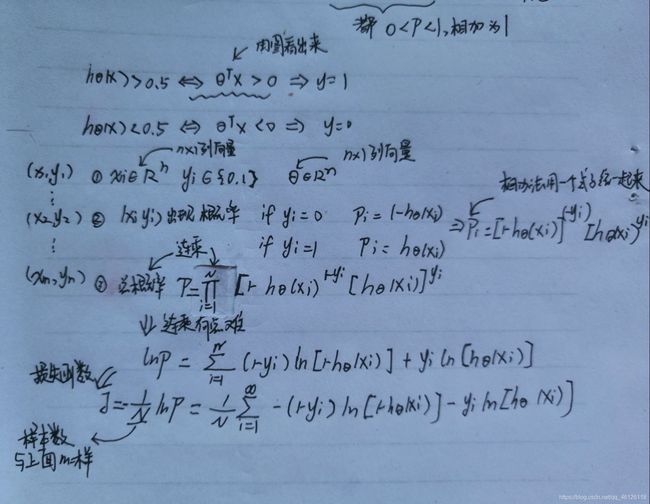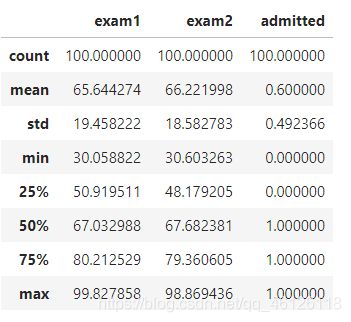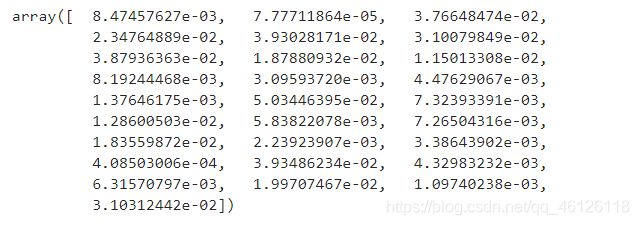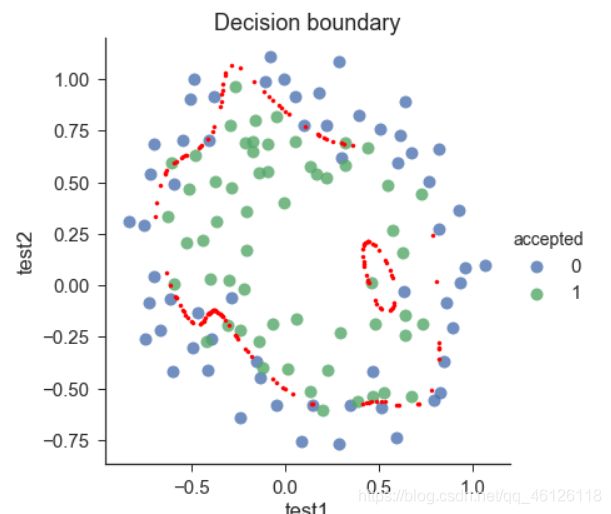吴恩达机器学习作业2(逻辑回归)
逻辑回归
- 一.知识回顾
- 二.题目
- 二.编程的设计
-
- 【1】引入一些包
- 【2】准备数据
- 【3】sigmoid 函数
- 【4】cost function(代价函数)
-
- 1.设置参数
- 【5】gradient descent(梯度下降)
-
- 1.损失梯度的推导
- 2.代码
- 【6】拟合参数
- 【7】用训练集预测和验证
- 【7】寻找决策边界
-
- 1.输出最后拟合的参数
- 2.根据边界公式计算 X × θ X \times \theta X×θ
- 3.画出图形
- 三. 正则化逻辑回归
-
- 特征映射
-
- 对特征进行扩张
- 正则化函数
- regularized gradient(正则化梯度)
-
- 拟合参数
- 预测
- 使用不同的 (这个是常数)
-
- 画出决策边界
一.知识回顾
二.题目
题目概述:在训练的初始阶段,我们将要构建一个逻辑回归模型来预测,某个学生是否被大学录取。 设想你是大学相关部分的管理者,想通过申请学生两次测试的评分,来决定他们是否被录取。 现在你拥有之前申请学生的可以用于训练逻辑回归的训练样本集。对于每一个训练样本,你有他们两次测试的评分和最后是被录取的结果。
二.编程的设计
【1】引入一些包
import pandas as pd
import numpy as np
import matplotlib.pyplot as plt
import seaborn as sns
plt.style.use('fivethirtyeight')
import matplotlib.pyplot as plt
# import tensorflow as tf
from sklearn.metrics import classification_report#这个包是评价报告
【2】准备数据
data = pd.read_csv('ex2data1.txt', names=['exam1', 'exam2', 'admitted'])
data.head()#看前五行
data.describe()
sns.set(context="notebook", style="darkgrid", palette=sns.color_palette("RdBu", 2))
sns.lmplot('exam1', 'exam2', hue='admitted', data=data,
size=6,
fit_reg=False,
scatter_kws={"s": 50}
)
plt.show()#看下数据的样子
def get_X(df):#读取特征
# """
# use concat to add intersect feature to avoid side effect
# not efficient for big dataset though
# """
ones = pd.DataFrame({'ones': np.ones(len(df))})#ones是m行1列的dataframe
data = pd.concat([ones, df], axis=1) # 合并数据,根据列合并,concat拼接函数 ,相当于特征进行扩展
return data.iloc[:, :-1].as_matrix() # 这个操作返回 ndarray,不是矩阵,-1表示最后一列,但是左开右闭,所以正好是扩展后的前三列
def get_y(df):#读取标签(去最后一列)
# '''assume the last column is the target'''
return np.array(df.iloc[:, -1]) #df.iloc[:, -1]是指df的最后一列
def normalize_feature(df):
# """Applies function along input axis(default 0) of DataFrame."""
return df.apply(lambda column: (column - column.mean()) / column.std())#特征缩放 (每一列的元素-每一列的均值)/每一列的方差
X = get_X(data)
print(X.shape)
y = get_y(data)
print(y.shape)
(100, 3)
(100,) # 这是一个列向量
【3】sigmoid 函数
g 代表一个常用的逻辑函数(logistic function)为S形函数(Sigmoid function),公式为: g ( z ) = 1 1 + e − z g\left( z \right)=\frac{1}{1+{{e}^{-z}}} g(z)=1+e−z1
合起来,我们得到逻辑回归模型的假设函数:
h θ ( x ) = 1 1 + e − θ T X {{h}_{\theta }}\left( x \right)=\frac{1}{1+{{e}^{-{{\theta }^{T}}X}}} hθ(x)=1+e−θTX1
def sigmoid(z):
return 1 / (1 + np.exp(-z))
fig, ax = plt.subplots(figsize=(8, 6))
ax.plot(np.arange(-10, 10, step=0.01),
sigmoid(np.arange(-10, 10, step=0.01)))
ax.set_ylim((-0.1,1.1))
ax.set_xlabel('z', fontsize=18)
ax.set_ylabel('g(z)', fontsize=18)
ax.set_title('sigmoid function', fontsize=18)
plt.show()
【4】cost function(代价函数)
- m a x ( ℓ ( θ ) ) = m i n ( − ℓ ( θ ) ) max(\ell(\theta)) = min(-\ell(\theta)) max(ℓ(θ))=min(−ℓ(θ))
- choose − ℓ ( θ ) -\ell(\theta) −ℓ(θ) as the cost function
1.设置参数
theta = theta=np.zeros(3) # X(m*n) so theta is n*1
theta
# array([ 0., 0., 0.])
def cost(theta, X, y):
''' cost fn is -l(theta) for you to minimize'''
return np.mean(-y * np.log(sigmoid(X @ theta)) - (1 - y) * np.log(1 - sigmoid(X @ theta)))
# X @ theta与X.dot(theta)等价
cost(theta, X, y)
# 0.69314718055994529
【5】gradient descent(梯度下降)
1.损失梯度的推导
- 这是批量梯度下降(batch gradient descent)
- 转化为向量化计算: 1 m X T ( S i g m o i d ( X θ ) − y ) \frac{1}{m} X^T( Sigmoid(X\theta) - y ) m1XT(Sigmoid(Xθ)−y)
∂ J ( θ ) ∂ θ j = 1 m ∑ i = 1 m ( h θ ( x ( i ) ) − y ( i ) ) x j ( i ) \frac{\partial J\left( \theta \right)}{\partial {{\theta }_{j}}}=\frac{1}{m}\sum\limits_{i=1}^{m}{({{h}_{\theta }}\left( {{x}^{(i)}} \right)-{{y}^{(i)}})x_{_{j}}^{(i)}} ∂θj∂J(θ)=m1i=1∑m(hθ(x(i))−y(i))xj(i)
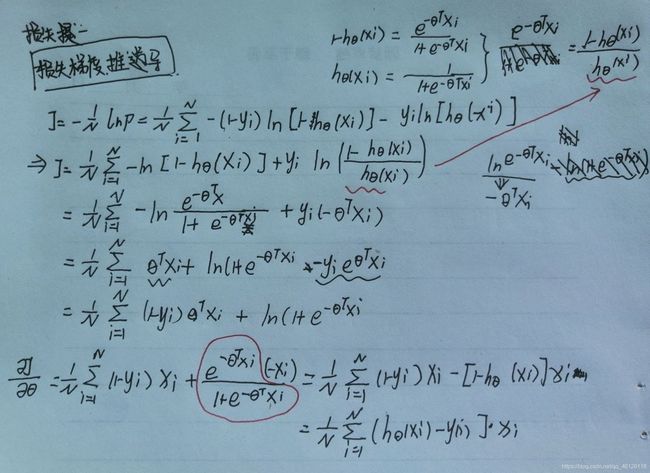
2.代码
def gradient(theta, X, y):
# '''just 1 batch gradient'''
return (1 / len(X)) * X.T @ (sigmoid(X @ theta) - y)
gradient(theta, X, y)
# array([ -0.1 , -12.00921659, -11.26284221])

【6】拟合参数
这里我使用 scipy.optimize.minimize 去寻找参数
import scipy.optimize as opt
res = opt.minimize(fun=cost, x0=theta, args=(X, y), method='Newton-CG', jac=gradient)
print(res)
【7】用训练集预测和验证
def predict(x, theta):
prob = sigmoid(x @ theta)
return (prob >= 0.5).astype(int)
final_theta = res.x
y_pred = predict(X, final_theta)
print(classification_report(y, y_pred))

查准率(Precision)和查全率(Recall)
见:
这两个越高越好
具体介绍见我的笔记吴恩达机器学习day8(机器学习系统的设计)
【7】寻找决策边界
X × θ = 0 X \times \theta = 0 X×θ=0 (this is the line)
1.输出最后拟合的参数
print(res.x) # this is final theta
# [-25.16227358 0.20623923 0.20147921]
2.根据边界公式计算 X × θ X \times \theta X×θ
coef = -(res.x / res.x[2]) # find the equation
print(coef)
x = np.arange(130, step=0.1)
y = coef[0] + coef[1]*x
# [ 124.88769463 -1.0236254 -1. ]
data.describe() # find the range of x and y
3.画出图形
sns.set(context="notebook", style="ticks", font_scale=1.5)
sns.lmplot('exam1', 'exam2', hue='admitted', data=data,
size=6,
fit_reg=False,
scatter_kws={"s": 25}
)
plt.plot(x, y, 'grey')
plt.xlim(0, 130)
plt.ylim(0, 130)
plt.title('Decision Boundary')
plt.show()
三. 正则化逻辑回归
df = pd.read_csv('ex2data2.txt', names=['test1', 'test2', 'accepted'])
df.head()
sns.set(context="notebook", style="ticks", font_scale=1.5)
sns.lmplot('test1', 'test2', hue='accepted', data=df,
size=6,
fit_reg=False,
scatter_kws={"s": 50}
)
plt.title('Regularized Logistic Regression')
plt.show()

由于无法用一个直线区分,我们是无法用逻辑回归分类哦,所以要用特征映射,将低微映射映射到高维特征
特征映射
对特征进行扩张
x1 = np.array(df.test1)
x2 = np.array(df.test2)
data = feature_mapping(x1, x2, power=6)
print(data.shape)
data.head() #(118, 28)
正则化函数
J ( θ ) = 1 m ∑ i = 1 m [ − y ( i ) log ( h θ ( x ( i ) ) ) − ( 1 − y ( i ) ) log ( 1 − h θ ( x ( i ) ) ) ] + λ 2 m ∑ j = 1 n θ j 2 J\left( \theta \right)=\frac{1}{m}\sum\limits_{i=1}^{m}{[-{{y}^{(i)}}\log \left( {{h}_{\theta }}\left( {{x}^{(i)}} \right) \right)-\left( 1-{{y}^{(i)}} \right)\log \left( 1-{{h}_{\theta }}\left( {{x}^{(i)}} \right) \right)]}+\frac{\lambda }{2m}\sum\limits_{j=1}^{n}{\theta _{j}^{2}} J(θ)=m1i=1∑m[−y(i)log(hθ(x(i)))−(1−y(i))log(1−hθ(x(i)))]+2mλj=1∑nθj2
theta = np.zeros(data.shape[1])
X = feature_mapping(x1, x2, power=6, as_ndarray=True)
print(X.shape)
y = get_y(df)
print(y.shape)
(118, 28)
(118,)
def regularized_cost(theta, X, y, l=1):
# '''you don't penalize theta_0'''
theta_j1_to_n = theta[1:]
regularized_term = (l / (2 * len(X))) * np.power(theta_j1_to_n, 2).sum()
return cost(theta, X, y) + regularized_term
#正则化代价函数
regularized_cost(theta, X, y, l=1)
0.6931471805599454
因为我们设置theta为0,所以这个正则化代价函数与代价函数的值相同
regularized gradient(正则化梯度)
∂ J ( θ ) ∂ θ j = ( 1 m ∑ i = 1 m ( h θ ( x ( i ) ) − y ( i ) ) ) + λ m θ j for j ≥ 1 \frac{\partial J\left( \theta \right)}{\partial {{\theta }_{j}}}=\left( \frac{1}{m}\sum\limits_{i=1}^{m}{\left( {{h}_{\theta }}\left( {{x}^{\left( i \right)}} \right)-{{y}^{\left( i \right)}} \right)} \right)+\frac{\lambda }{m}{{\theta }_{j}}\text{ }\text{ for j}\ge \text{1} ∂θj∂J(θ)=(m1i=1∑m(hθ(x(i))−y(i)))+mλθj for j≥1
def regularized_gradient(theta, X, y, l=1):
# '''still, leave theta_0 alone'''
theta_j1_to_n = theta[1:]
regularized_theta = (l / len(X)) * theta_j1_to_n
# by doing this, no offset is on theta_0
regularized_term = np.concatenate([np.array([0]), regularized_theta])
return gradient(theta, X, y) + regularized_term
regularized_gradient(theta, X, y)
拟合参数
import scipy.optimize as opt
print('init cost = {}'.format(regularized_cost(theta, X, y)))
res = opt.minimize(fun=regularized_cost, x0=theta, args=(X, y), method='Newton-CG', jac=regularized_gradient)
res
预测
final_theta = res.x
y_pred = predict(X, final_theta)
print(classification_report(y, y_pred))
使用不同的 (这个是常数)
画出决策边界
我们找到所有满足 ×=0 的x
instead of solving polynomial equation, just create a coridate x,y grid that is dense enough, and find all those × that is close enough to 0, then plot them
def draw_boundary(power, l):
# """
# power: polynomial power for mapped feature
# l: lambda constant
# """
density = 1000
threshhold = 2 * 10**-3
final_theta = feature_mapped_logistic_regression(power, l)
x, y = find_decision_boundary(density, power, final_theta, threshhold)
df = pd.read_csv('ex2data2.txt', names=['test1', 'test2', 'accepted'])
sns.lmplot('test1', 'test2', hue='accepted', data=df, size=6, fit_reg=False, scatter_kws={"s": 100})
plt.scatter(x, y, c='R', s=10)
plt.title('Decision boundary')
plt.show()
def feature_mapped_logistic_regression(power, l):
# """for drawing purpose only.. not a well generealize logistic regression
# power: int
# raise x1, x2 to polynomial power
# l: int
# lambda constant for regularization term
# """
df = pd.read_csv('ex2data2.txt', names=['test1', 'test2', 'accepted'])
x1 = np.array(df.test1)
x2 = np.array(df.test2)
y = get_y(df)
X = feature_mapping(x1, x2, power, as_ndarray=True)
theta = np.zeros(X.shape[1])
res = opt.minimize(fun=regularized_cost,
x0=theta,
args=(X, y, l),
method='TNC',
jac=regularized_gradient)
final_theta = res.x
return final_theta
def find_decision_boundary(density, power, theta, threshhold):
t1 = np.linspace(-1, 1.5, density)
t2 = np.linspace(-1, 1.5, density)
cordinates = [(x, y) for x in t1 for y in t2]
x_cord, y_cord = zip(*cordinates)
mapped_cord = feature_mapping(x_cord, y_cord, power) # this is a dataframe
inner_product = mapped_cord.as_matrix() @ theta
decision = mapped_cord[np.abs(inner_product) < threshhold]
return decision.f10, decision.f01
#寻找决策边界函数
draw_boundary(power=6, l=1)#lambda=1
draw_boundary(power=6, l=0) # no regularization, over fitting,#lambda=0,没有正则化,过拟合了
draw_boundary(power=6, l=100) # underfitting,#lambda=100,欠拟合




